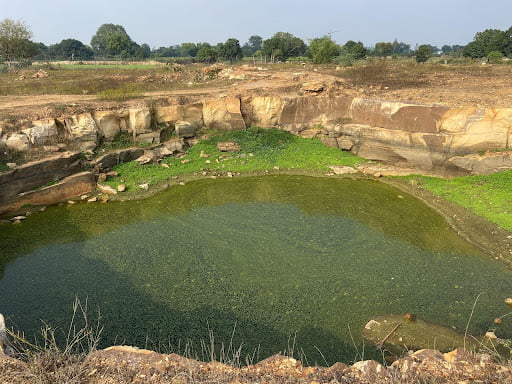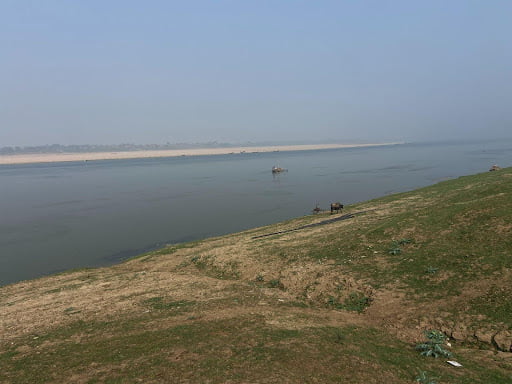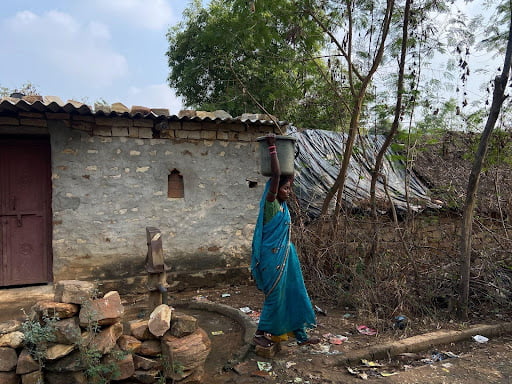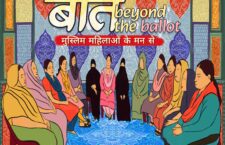Summers in Bundelkhand bring not only scorching temperatures but also water scarcity, making life difficult for locals. This report takes a closer look at the lives of women in Uttar Pradesh’s Mahoba and Mau districts – they walk long distances, grapple with defunct hand pumps, endure extreme heat, and risk their health as they secure water for their families.
This report was submitted as part of the Khabar Lahariya Rural Media Fellowship by Gafira Qadir and Khabar Lahariya Senior Reporter Sunita Devi.
Phoolkali’s day starts at 6 AM. Dressed in a simple green saree, with tired eyes and a slender frame, she begins her daily trek to the village borewell, carrying two containers, ready to fetch water for her family.
But a few months ago, her routine took a tough blow. While heaving a water-filled bucket onto her shoulder, her knee collided with the hard borewell structure, resulting in an audible snap. “Since then, I have been dealing with persistent pain,” Phoolkali shares, her voice tinged with exhaustion. “Standing for long hours only makes it worse, but I have no choice. My family needs water, so I push through.”
‘This is part of an old cultural practice where it is believed that women are solely responsible for fetching water,’ says Ashok Kumar, Director at Abhiyan, an NGO working on water management and women empowerment in rural areas of Banda and Chitrakoot districts in Bundelkhand. “So the women suffer the most due to water scarcity.”
Phoolkali lives in a shanty in Chipiya village, part of Janva gram panchayat in Uttar Pradesh’s Mahoba district. This area lies within the Bundelkhand region, home to over 18.3 million people, and 79.1% of population lives in rural areas (Census 2011). Characterised by its rough terrain and hilly landscapes, the region grapples with water scarcity issues. For years, drought-like conditions and insufficient water resources have plagued the area. Moreover, the rocky terrain and uneven hills further complicate efforts for water retention and groundwater replenishment.

Women queue up at the nearest hand pump in the early morning to fetch water for their families. Credits: Gafira Qadir
Every day, women in villages across Bundelkhand undertake the arduous journey of walking miles to collect water for their households. Often, they carry heavy jars, containers, or buckets on their heads. This already strenuous task is exacerbated by the sweltering heat, leaving them physically drained.
Research conducted by the National Institute of Disaster Management in 2014 revealed a concerning trend: severe drought years have significantly increased in the last three decades in Bundelkhand. Gaya Prasad, affectionately known as Gopal Bhai to locals, the founder of Akhil Bhartiya Samaj Sewa Sansthan (ABSSS), a non-profit organisation that works on water scarcity and its gendered impact in the region, emphasises that many villages in the region struggle with water scarcity, with women bearing the brunt of the burden.
According to International Development Enterprises (IDE), women spend some 150 million days annually collecting water in India, resulting in a national income loss of ₹10 billion each year.
In this era of data-driven and supported decisions, there remains a dearth of comprehensive and up-to-date data available on water scarcity in Bundelkhand, particularly its impact on women. While there is some data mapping the time they spend collecting water, there is a lack of focus on understanding its broader implications for their health, education, and overall well-being.
Also Read: Paani Door Hai: Women & Water in Bundelkhand
Facing the Heat
Bitol, a 60-year-old woman, dons a printed blue saree, bearing visible wounds on the left side of her face. A month ago, under the scorching sun, Bitol made her daily trip to the borewell. Overwhelmed by the heat, she felt dizzy, lost her balance, and fell, sustaining injuries. Despite her age and weakened state, Bitol fetches water three times a day to sustain herself and her husband. She shares, “If I don’t, then we will face the same fate as our son.”
Five years ago, Bitol’s son was working in a nearby field and began feeling dizzy due to the extreme heat. With no potable water available, he returned home to find no water there either. He collapsed and passed away shortly after. Bitol believes her son succumbed to the heatwave. Tearfully, she remarks, “I am awaiting the same fate.”
According to data presented by the Union Minister of State for Health and Family Welfare, S.P. Singh Baghel, 252 deaths were reported due to heatwave in the first half of 2023.
As per the National Crime Records Bureau (NCRB), heatstroke fatalities in India from 2012 to 2021 exceeded 11,000. Bihar recorded more than 1,000 deaths, while Uttar Pradesh saw over 1,500 mortalities.
Bitol, with her thin legs and weakened constitution, struggles under the heat; her vision is blurred. Standing in queues exacerbates her vulnerability, leading to dizziness, fever, and nausea. “My health has deteriorated, and I’m simply anticipating death at this point,” she said, anxiously fidgeting with her fingers. “It doesn’t matter if I die today or tomorrow; nothing is going to change for us.”
Gopal Bhai notes, “Women wait for long hours in queues, irrespective of their health issues, to fetch water for their households. Collecting water is only considered to be the responsibility of women in the family.”
Kishan Kumar, Pradhan (village chief) of Janva, said, “We have 76 hand pumps and 48 wells in Janva, and the area has been facing water scarcity for a long time. We are building pipelines for the water resource as well as trying to provide a tanker facility for water storage soon.”
However, the women in the village don’t believe in their pradhan. “Pradhan never listens to us. I don’t think he will do anything,” Bitol and many other women said.
Every morning at 7 AM, Bitol walks over half a kilometre towards the borewell in her hamlet. “I fill over six containers and buckets a day,” she said. “Sometimes, it seems like my brain has stopped working because of the heat. It is very difficult to fetch water in the scorching sun.”
Also Read: Jal Jeevan Mission in UP : Few Taps In Banda, Taps But Not Enough Water in Baghpat
Miles to Walk
In Gurehtha village, located in Uttar Pradesh’s Mau district, the hand pumps have been out of order for months. Armed with 15-litre containers, the women here embark on a daily trek to the Yamuna river, covering vast distances twice a day to fetch water. Muti Sitaram, an 85-year-old resident, explains, “We carry four containers at once to ensure we have enough water for our household needs.”
However, this routine takes its toll. The weight of the water-filled vessels strains their bodies, leaving them with joint pain and fevers. Muti reflects on their plight, questioning, “Do we have any other alternative? Nobody, not even the pradhan, listens to our grievances.”
In times of illness, when the women of the family are unable to fetch water, they rely on the kindness of their neighbours. Muti reveals, “Many women in the village are unwell but still continue to fetch water. It’s a matter of survival for us, or else we’re left waiting for death.”
Ram Babu Tiwari, an environmentalist hailing from Chitrakoot, expressed concerns over the deteriorating environmental conditions in Bundelkhand. He attributed this decline to rampant mining and rapid urbanisation, which have adversely impacted the region’s water sources. Tiwari remarked, “Previously, Bundelkhand boasted numerous water bodies, but now, due to silting and inadequate water management, they have dwindled significantly.”
Tiwari also highlighted the erratic nature of rainfall patterns in the area. He noted, “We used to experience prolonged and consistent monsoons, but now, rainfall is sporadic and insufficient, often followed by extended dry spells.” This unpredictability, he added, poses challenges for effective water storage.
“It’s crucial for us to prioritise water conservation and environmental protection,” said Ram Babu.
Meanwhile, along the banks of the Yamuna river, the rhythmic footsteps of women reverberate as they shoulder the responsibility of providing water for their households. In this enduring tradition, water collection transcends mere chore—it embodies a gendered legacy deeply etched into the community’s fabric.
For generations, cultural norms have confined the task of drawing water solely to women, a duty so deeply ingrained that men venturing into this essential chore is deemed dishonourable. “It is considered a shame for the men if they fetch water for us. They never do it,” says Sonu, 20.
In a society where gender roles are firmly entrenched, the act of water collection becomes a symbolic dance between tradition and the resilience of women. Even during their menstrual cycles, women persevere, navigating the physical discomfort and societal taboos to ensure their families’ sustenance. “It becomes very difficult but what choice do I have?” Sonu remarks.
In a bid to tackle health risks associated with contaminated water, Abhiyan NGO has launched initiatives to train villagers in water quality testing. Director Ashok Kumar remains hopeful about the government’s ‘Har Ghar Jal Yojna,’ stating, “The government will soon provide tap water facilities here.” While appreciating the government’s efforts in laying pipes in villages, he acknowledges that it will take time for water supply to begin.
Under Prime Minister Narendra Modi’s ‘Har Ghar Nal Yojana,’ Uttar Pradesh Chief Minister Yogi Adityanath announced in 2022 that tap water connections would be available in homes across the parched Vindhyachal and Bundelkhand regions by December 2024.
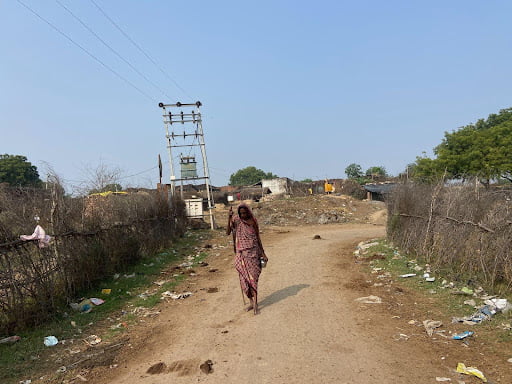
An elderly woman walks to defecate in the open, holding a tumbler of muddy water. Credits: Gafira Qadir
Despite these promises, locals remain sceptical. “I have witnessed the same problems for decades, and nothing has ever improved, nor will it ever,” says Ramsamari, 45. “This is our reality now. No matter how often we raise our voices, no one listens,” she concludes.
To explore Khabar Lahariya’s work on Bundelkhand’s water crisis, check out this water map.
Photo of Khabar Lahariya Rural Media Fellow Gafira Qadir
and Khabar Lahariya Senior Reporter Sunita Devi
Kow more about Chambal Media Rural Reporting Tool Kit (here).



